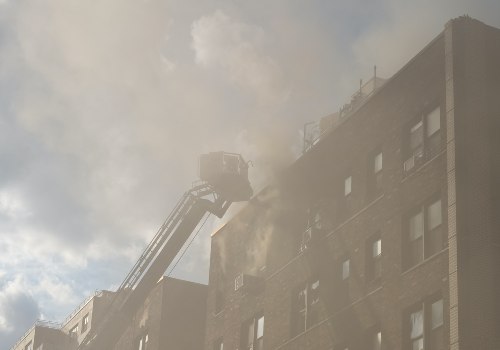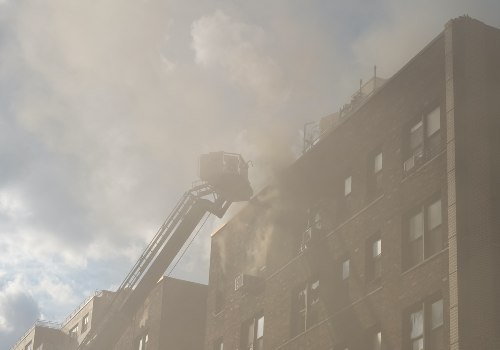
– 15th October 2022; A large fire breaks out at a building site in the centre of Leeds.
The cause of the fire seems to have been a stray firework, which has ignited the sheeting covering the scaffolding in place.
Romero’s Technical Claim’s Director, Stuart Dobbins, identifies how coverage limits and the details of the fire affect the claims process and ultimately a business’s insurance.
Scaffolding Sheeting and Fire – Compliance & Certification
Often, the terms ‘compliance’ and ‘certification’ are used as synonyms to describe the authentication and general approval of processes. If a boiler engineer is ‘gas certified’ this inherently implies that they are ‘compliant’ with whatever rules and regulations apply to their industry.
However when it comes to scaffolding sheeting, the terms ‘compliance’ and ‘certification’ actually represent quite different principles, which in turn have very different implications for the fire safety and fire retardancy of a building.
In effect, compliance is a much lower base line for the use of materials. If a scaffolding’s sheeting is ‘compliant’ it has been subject to a one-off test based on a single sample, and there is no automatic guarantee that any fire retardancy standards will have been checked to a recognisable level in this process.
‘Certification’, however, involves a much higher standard being applied to materials, with a number of regulated tests being carried out by independent, accredited bodies. These tests involve an assessment of the relevant materials’ capacity for preventing the spread of fire on both internal and external scaffolding, and even after certification the materials are subject to regular tests and audits, with full ISO 9001 accreditation and batch traceability. These assessments also take into account the differing fire retardancy properties of the inks utilised on printed sheeting.
The importance of certification
Clearly the first reason why certification of scaffolding sheeting is so important is that it provides comfort for both contractors and property owners that the building is unlikely to be subject to a significant fire, and, in turn, that the safety of employees and the public is protected. However the failure to utilise certified sheeting can also cause problems in terms of the arrangement of insurance, with stipulations being made by the Joint Code of Practice on the Protection from Fire of Construction Sites and Buildings Undergoing Renovation (JCC) that certification is required depending on the nature and value of the project being undertaken. Insurance policies will often incorporate these JCC conditions, meaning that the arrangement of cover will be contingent upon certification being obtained. In turn, the lack of certification on a project wherein the insurance policy requires it can lead to the withdrawal of cover by the insurer, leaving scaffolders exposed to very significant claims without any insurance to meet their cost.
This principle is further underlined by directions from the HSE following the Grenfell disaster, specifically in relation to the management of fire risk in buildings which are subject to the removal and replacement of cladding. On these types of job, the HSE make very clear that any sheeting or netting must be flame retardant to the certified LPS1215/TS62 standard. However the HSE also makes clear that the LPS1215 ‘flame retardant’ sheeting is only designed to stop flames spreading, not to keep a fire trapped inside. Scaffolders should be aware that certified sheeting is not a ‘one-size-fits-all’ solution to the management of fire risks, and the HSE articulate a number of additional requirements for buildings subject to this type of replacement cladding work.
Insurance claims – Who is at fault?
To return to the incident at the start of this document, the question must be asked as to whether the scaffolder in question has to accept any liability for the damage being sustained to the building on which work is taking place. Needless to say, this is a complex area and no categoric conclusions can be drawn simply on the basis of news stories about the fire. All claims of this type require in-depth forensic investigation, and therefore any comments below are merely speculation to highlight the complexity of the issue.
What caused the fire?
This is obviously the first question that should be asked in any incident, and the fire in Leeds City Centre is no different. However, the information available from news sources is patchy, and one is relying on a lot of anecdotal evidence to indicate how the fire began. However, it seems likely that a stray firework caught the sheeting around the building, which in turn caused the fire to start and spread to the building beneath.
If the cause of the incident was a stray firework, it may seem straightforward to suggest that liability rests with a person or persons unknown who happened to let off said firework in the vicinity of the property. However liability claims, as well as prosecutions by the HSE, do not often stop at the ‘primary’ cause of the incident, and they will often look at aggravating factors, negligent omissions and breaches of regulations that could have exacerbated the incident and made damage or injury much more likely. In essence, one is looking at what is known as a ‘but for’ test, which in the most negative construction could be the following: ‘but for’ the lack of certified sheeting around the building, the fire would never have occurred.
Coverage
Clearly, post-Grenfell, all public organisaitons are very mindful of fire safety in buildings and therefore incidents such as the fire in Leeds City Centre are likely to involve close scrutiny of the actions of the scaffolder and their adherence to the required fire safety conditions both within the law and within their insurance policy. As mentioned above, failure to satisfy the policy conditions can lead to a withdrawal of cover by insurers, meaning that a business will be unsupported in dealing with the myriad complex claims that follow a serious incident.
Other factors?
Even if the contractor complied with the terms of their policy, there are still likely to be questions asked about the safety and the ‘reasonableness’ of the sheeting being used. Given that this building was in the central square of Leeds over the period of Bonfire Night, would it seem likely that fireworks could be a hazard? Should the company have employed a fire marshal over this period? Should they have taken the sheeting down completely at this time? These are questions that can not be answered easily, but insurers and the HSE will nonetheless want to see that a business has considered the likely causes of ignition and taken steps to minimise the risks from the same.
Conclusion
In the wake of the Grenfell tragedy and the heightened scrutiny of all companies involved in work on tall buildings, it is absolutely crucial that scaffolders take all possible steps to protect themselves and others from the risk of fire. Aside from simply being good practice, robust approaches to risk assessment and certification will give a business a positive chance of defending any claims that may be made or prosecutions that are considered by the HSE and other public bodies.
Professional Indemnity Insurance
Ask yourself this: could you survive financially if your business was hit by hefty legal bills and compensation payouts? Professional Indemnity Insurance is your financial back-up, there to provide peace of mind that human error won’t make or break your business.
We all make mistakes. But don’t end up footing the bill for yours. Read our range of articles on Professional Indemnity insurance to learn more, or contact us to get your insurance solutions sorted.



